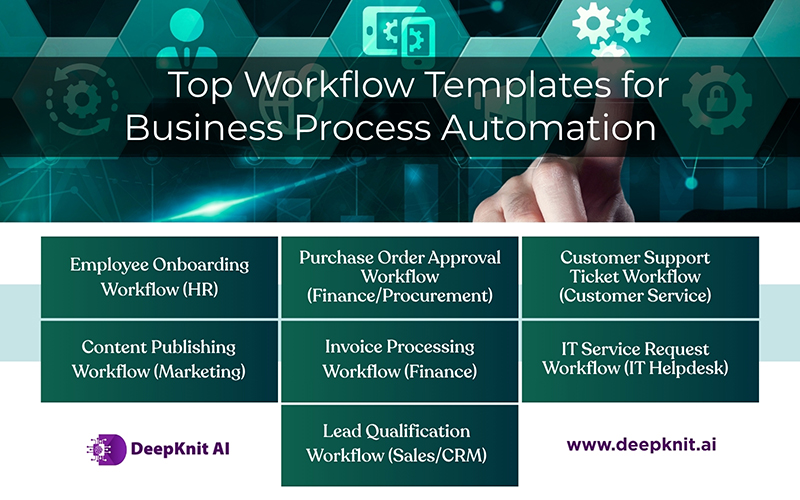Ever given a thought about how much enterprises waste time on processing daily, repetitive tasks?
According to a McKinsey report, it is estimated that around 30% of work hours can be automated using existing technologies. Even then, the majority of organizations fail to adopt AI successfully into their operations. Why? It’s because the entire process of building workflows from scratch is straight up overwhelming.
This is where workflow templates for business process automation come to the rescue. It is essentially a shortcut towards smarter and faster business process automation (BPA). Instead of reinventing the wheel, it is better to make use of proven frameworks to get started and improve efficiency significantly, across all departments.
In this post, we shall explore the best workflow templates for automation that can be used to accelerate automation, reduce errors and streamline operations. These digital workflow solutions offer a faster, smarter way to streamline operations by replacing manual steps with standardized workflow templates that are easy to deploy across departments.
Regardless of whether the use case is in HR, finance, customer service, or IT—using ready-to-use workflow templates for business efficiency allows you to reduce errors, shorten cycle times, and scale without starting from scratch. And if you’re ready to take automation to the next level, we’ll also demonstrate how DeepKnit AI can help you scale intelligently with AI-powered automation workflows.
What Are Workflow Templates?
A workflow template is a pre-defined, reusable model of a business process. In simpler terms, consider it to be a blueprint for automation that helps in outlining key steps, decision points, required inputs, and desired outcomes. These templates save time, minimize the complexities involved in setting it up, and promote best practices in BPA.
Templates are not one-dimensional; they can range from simple task checklists to complex cross-departmental processes with integrated approvals, data collection, and analytics.
What Is the Significance of Workflow Templates for BPA?
Are you still debating whether to use templates for automation? Here are a few benefits that might sway your decision in their favor:
- Faster implementation: With workflow templates in place, you no longer have to wait weeks of process mapping and can go live sooner.
- Error reduction: All workflow templates—by default—follow tested, standardized procedures that minimize possibilities of any mistakes.
- Easy scaling: The availability of customizable, read-to-use workflow templates makes it easier to use across teams or branches.
- Clarity and transparency: When you have a workflow template within your organization, it makes it easy for everyone to know their role in the process.
- AI-readiness: Many templates can be integrated with smart AI tools like DeepKnit AI to automate decisions and optimize workflows continuously.
The Top Workflow Templates Required to Kickstart Automation
Now, let’s get down to understanding the most essential templates you can start using immediately, categorized by business function.
-
- Employee Onboarding Workflow (HR)
Why it matters: First impressions matter. A streamlined onboarding process is what will set the tone for productivity and retention.
Key steps:
-
-
- Trigger: Offer letter accepted
- IT setup request
- Document collation and e-signature
- Role-specific training schedule
- HR welcome meeting
- Feedback form after 4 weeks
-
Bonus: With AI support DeepKnit AI’s RPA agents, you can create custom training modules based on the employee’s role and learning style.
-
- Purchase Order Approval Workflow (Finance/Procurement)
Why it matters: Unauthorized spending or delayed approvals can unsettle budgets and operations; regardless of the size of the business.
Key steps:
-
-
- Purchase request submitted
- Automated budget check
- Manager approval
- Vendor selection
- PO creation and dispatch
- Receipt confirmation
-
Optimize with AI: Integrate AI tools that have the contextual capability to predict approval bottlenecks or flag unusual spending patterns for fraud prevention.
-
- Customer Support Ticket Workflow (Customer Service)
Why it matters: Prompt resolutions lead to loyal customers.
Key steps:
-
-
- Ticket logged via email/chat
- Priority and type classification
- Assignment to support agent
- Resolution steps and customer updates
- Ticket closure with satisfaction survey
-
Pro Tip: Today’s business automation tools are generically capable of auto-classifying tickets by sentiment and urgency, helping agents respond faster and more effectively.
-
- Content Publishing Workflow (Marketing)
Why it matters: A clear workflow ensures consistent branding and timely delivery, leading to favorable outcomes.
Key steps:
-
-
- Content idea submission
- Draft writing
- Editor review
- Design team collaboration
- Final approval
- Schedule/publish
-
AI integration: Make use of AI that can optimize content headlines, forecast SEO outcomes, and suggest publishing times.
-
- Invoice Processing Workflow (Finance)
Why it matters: For any business, late payments mean late fees and/or strained vendor relationships.
Key steps:
-
-
- Invoice received (email or upload)
- Data extraction
- Matching with PO
- Approval chain
- Payment scheduling
- Archival
-
Accelerate with AI: DeepKnit AI can help automate data extraction from unstructured invoice formats, reducing manual entry, minimizing errors, and improving results.
-
- IT Service Request Workflow (IT Helpdesk)
Why it matters: Time is of essence and faster issue resolution means less downtime and better client satisfaction.
Key steps:
-
-
- Request form submitted
- Issue category auto-tagged
- Assignment to technician
- Troubleshooting steps recorded
- Resolution confirmation
- Feedback capture
-
Advanced AI add-on: AI-powered solutions can evaluate generic IT issues and suggest proactive solutions or auto-responses for repetitive queries.
-
- Lead Qualification Workflow (Sales/CRM)
Why it matters: Sales reps are often left with a mountain of data, sifting through to find the right lead. Instead, they should spend time on leads that are most likely to convert.
Key steps:
-
-
- Lead enters CRM from form/ad
- Auto enrichment from public data
- Scoring based on criteria
- Assignment to appropriate rep
- Outreach scheduling
-
Upgrade with AI: Use DeepKnit AI to predict high-converting leads, recommend outreach timing, or even auto-generate personalized messages.
Smart Workflows Start with Smarter Tools
While templates are a great place to start from, the overall efficiency comes from intelligence, i.e. learning from data, adjusting to trends, and optimizing outcomes in real time.
That’s where DeepKnit AI comes in.
With its advanced AI-powered automation tools, DeepKnit AI helps businesses:
- Convert static templates into dynamic, learning workflows
- Analyze performance data to predict bottlenecks and optimize processes
- Seamlessly integrate with your existing tech stack—CRM, ERP, helpdesk, etc.
- Build custom AI workflows tailored to industry-specific needs
How to Choose the Right Workflow Template
Choosing the best template depends on a few key factors:
- Frequency: Automate repetitive, high-volume tasks first.
- Intricacy: Begin with processes that have a well-defined logic and few exceptions.
- Impact: Focus on workflows that directly affect revenue, compliance, or customer satisfaction.
- Readiness: Make sure your team is aligned and your data is reliable.
Pro Tip: Don’t be afraid to customize templates. The goal is to create a workflow that truly reflects your team’s needs.
Final Thoughts
Workflow templates aren’t just another plug-and-play tool, they’re alchemists of innovation and scalability. When combined with AI, they can help your business move from manual clutter to automated clarity.
So, if you’re still stuck drawing flowcharts on whiteboards, maybe it’s time to explore smarter paths.
Ready to Level Up Your Automation Game?
When you collaborate with DeepKnit AI, your workflows don’t just run, they think.
Contact Us


